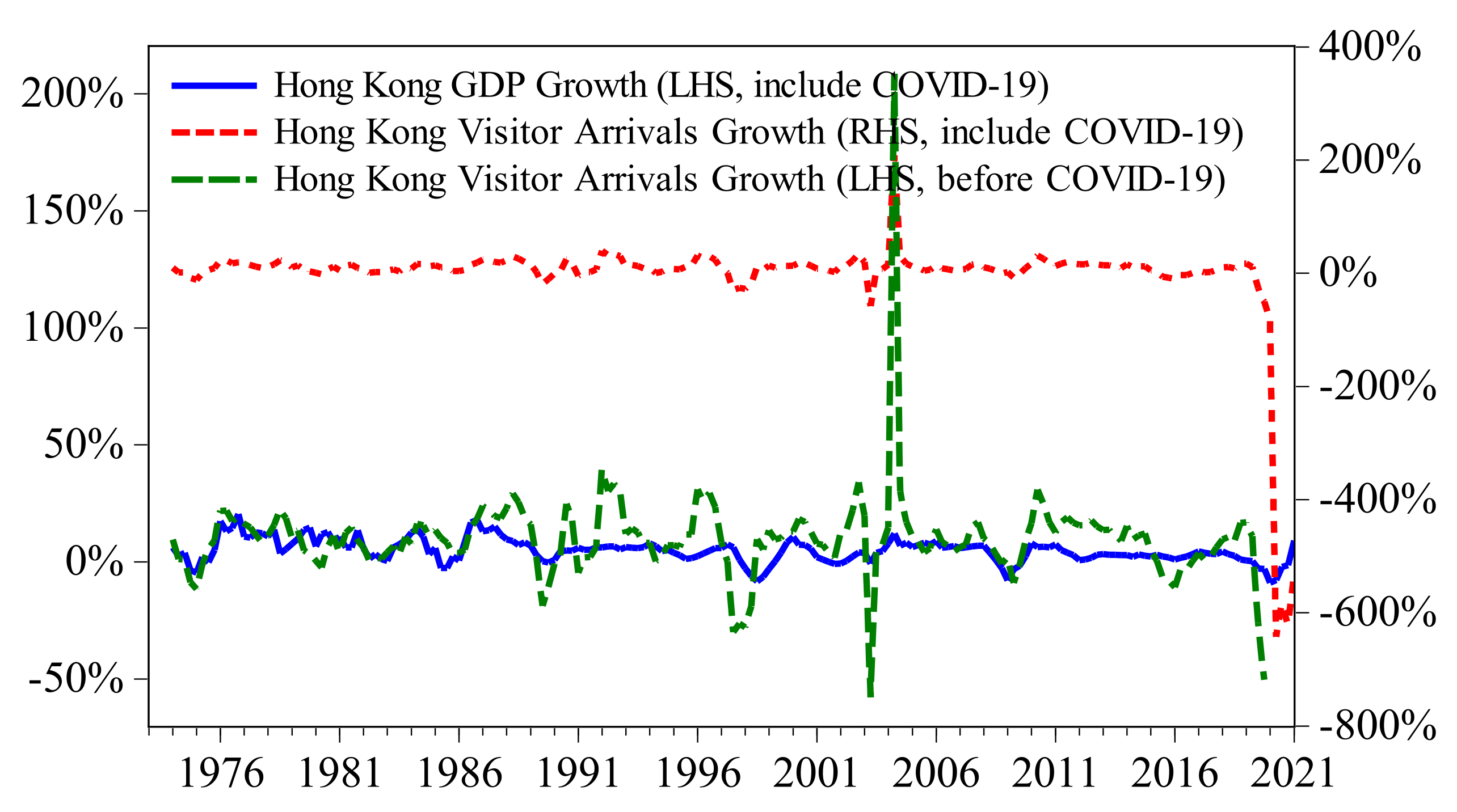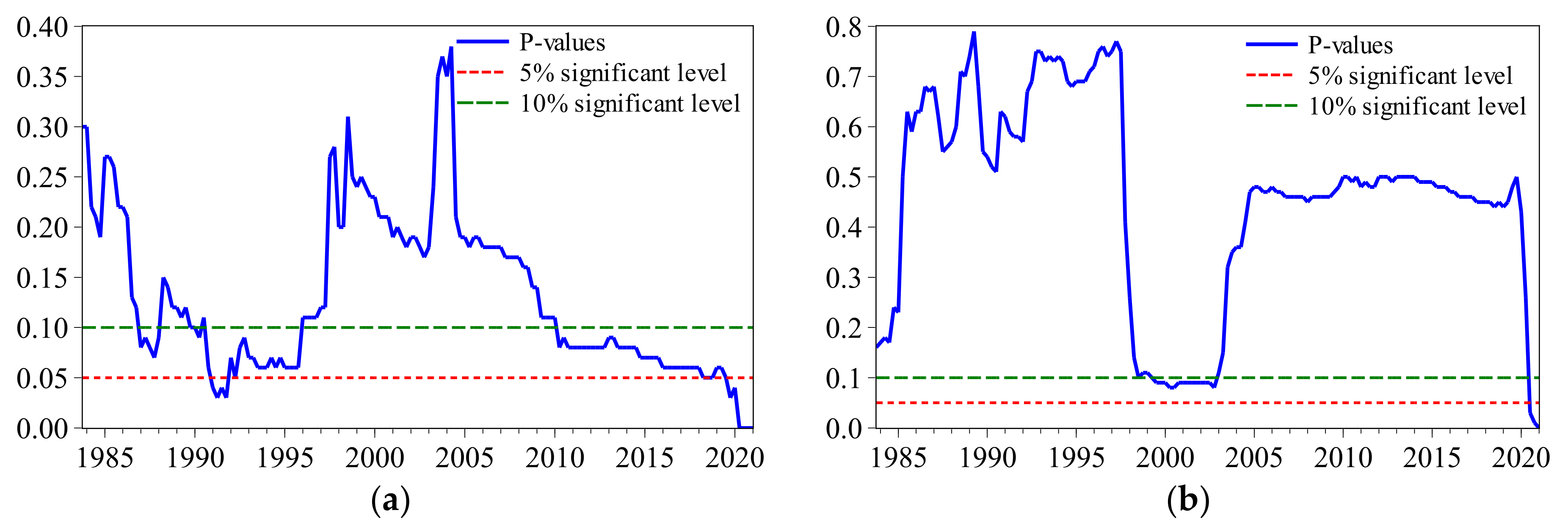Tourism–Growth Nexus in the Presence of Instability
Abstract
:1. Introduction
2. Literature Review
3. Materials and Methods
3.1. Methodology
3.2. Data
4. Results and Discussion
4.1. Traditional and Recursive Granger Causality Test
4.2. Robust Granger Causality Test
- Null hypothesis: GDPg does not Granger-cause VAg.
- Null hypothesis: VAg does not Granger-cause GDPg.
4.3. Has the Validity of TLEGH and EDTGH Changed during COVID-19?
5. Conclusions
Author Contributions
Funding
Institutional Review Board Statement
Informed Consent Statement
Data Availability Statement
Conflicts of Interest
References
- Blake, A.; Arbache, J.S.; Sinclair, M.T.; Teles, V. Tourism and poverty relief. Ann. Tour. Res. 2008, 35, 107–126. [Google Scholar] [CrossRef]
- Badulescu, A.; Badulescu, D.; Simut, R.; Dzitac, S. Tourism–economic growth nexus. The case of Romania. Technol. Econ. Dev. Econ. 2020, 26, 867–884. [Google Scholar] [CrossRef]
- Sehleanu, M. Analysis of foreign participation in the share capital of companies from the counties of North-West region of Romania. Orad. J. Bus. Econ. 2019, 4, 7–16. [Google Scholar] [CrossRef]
- Khan, H.; Seng, C.F.; Cheong, W.K. Tourism multiplier effects on Singapore. Ann. Tour. Res. 1990, 17, 408–418. [Google Scholar] [CrossRef]
- Liu, H.; Song, H.Y. New evidence of dynamic links between tourism and economic growth based on mixed-frequency Granger causality tests. J. Travel Res. 2017, 57, 899–907. [Google Scholar] [CrossRef]
- Alodadi, A.; Benhin, J. Religious tourism and economic growth in oil-rich countries: Evidence from Saudi Arabia. Tour. Anal. 2015, 20, 645–651. [Google Scholar] [CrossRef]
- Kumar, N.; Kumar, R.R.; Patel, A.; Stauvermann, P.J. Exploring the effect of tourism and economic growth in Fiji: Accounting for capital, labor, and structural breaks. Tour. Anal. 2019, 24, 115–130. [Google Scholar] [CrossRef]
- Leal Filho, W.; Brandli, L.L.; Lange Salvia, A.; Rayman-Bacchus, L.; Platje, J. COVID-19 and the UN sustainable development goals: Threat to solidarity or an opportunity? Sustainability 2020, 12, 5343. [Google Scholar] [CrossRef]
- Drozdowski, G. Economic calculus qua an instrument to support sustainable development under increasing risk. J. Risk Financ. Manag. 2021, 14, 15. [Google Scholar] [CrossRef]
- Song, H.; Wu, D.C. A critique of tourism-led economic growth studies. J. Travel Res. 2021, 00472875211018514. [Google Scholar] [CrossRef]
- Rossi, B.; Wang, Y. Vector autoregressive-based Granger causality test in the presence of instabilities. Stata J. Promot. Commun. Stat. Stata 2019, 19, 883–899. [Google Scholar] [CrossRef]
- Barnett, M.L.; Darnall, N.; Husted, B.W. Sustainability strategy in constrained economic times. Long Range Plan. 2015, 48, 63–68. [Google Scholar] [CrossRef]
- Ghali, M.A. Tourism and economic growth: An empirical study. Econ. Dev. Cult. Chang. 1976, 24, 527–538. [Google Scholar] [CrossRef]
- Pablo-Romero, M.d.P.; Molina, J.A. Tourism and economic growth: A review of empirical literature. Tour. Manag. Perspect. 2013, 8, 28–41. [Google Scholar] [CrossRef]
- Kyophilavong, P.; Gallup, J.L.; Charoenrat, T.; Nozaki, K. Testing tourism-led growth hypothesis in Laos? Tour. Rev. 2018, 73, 242–251. [Google Scholar] [CrossRef]
- Eeckels, B.; Filis, G.; Leon, C. Tourism income and economic growth in Greece: Empirical evidence from their cyclical components. Tour. Econ. 2012, 18, 817–834. [Google Scholar] [CrossRef]
- Bayramoğlu, T.; Arı, I. The relationship between tourism and economic growth in Greece economy: A time series analysis. Comput. Methods Soc. Sci. 2015, 3, 89–93. [Google Scholar]
- Balli, E.; Sigeze, C.; Manga, M.; Birdir, S.; Birdir, K. The relationship between tourism, CO2 emissions and economic growth: A case of Mediterranean countries. Asia Pac. J. Tour. Res. 2018, 24, 219–232. [Google Scholar] [CrossRef]
- Rivera, M.A. The synergies between human development, economic growth, and tourism within a developing country: An empirical model for Ecuador. J. Destin. Mark. Manag. 2017, 6, 221–232. [Google Scholar] [CrossRef]
- Wu, T.P.; Wu, H.C. The influence of international tourism receipts on economic development: Evidence from China’s 31 Major Regions. J. Travel Res. 2017, 57, 871–882. [Google Scholar] [CrossRef]
- Shahbaz, M.; Ferrer, R.; Shahzad, S.J.H.; Haouas, I. Is the tourism–economic growth nexus time-varying? Bootstrap rolling-window causality analysis for the top 10 tourist destinations. Appl. Econ. 2017, 50, 2677–2697. [Google Scholar] [CrossRef]
- Jebli, M.B.; Hadhri, W. The dynamic causal links between CO2 emissions from transport, real GDP, energy use and international tourism. Int. J. Sustain. Dev. World Ecol. 2018, 25, 568–577. [Google Scholar] [CrossRef]
- Enilov, M.; Wang, Y. Tourism and economic growth: Multi-country evidence from mixed-frequency Granger causality tests. Tour. Econ. 2021. [Google Scholar] [CrossRef]
- Ozturk, I.; Acaravci, A. On the causality between tourism growth and economic growth: Empirical evidence from Turkey. Transylv. Rev. Adm. Sci. 2009, 5, 73–81. [Google Scholar]
- Tang, C.-H.H.; Jang, S.S. The tourism–economy causality in the United States: A sub-industry level examination. Tour. Manag. 2009, 30, 553–558. [Google Scholar] [CrossRef]
- Lean, H.H.; Tang, C.F. Is the tourism-led growth hypothesis stable for Malaysia? A note. Int. J. Tour. Res. 2010, 12, 375–378. [Google Scholar] [CrossRef]
- Tang, C.F.; Tan, E.C. How stable is the tourism-led growth hypothesis in Malaysia? Evidence from disaggregated tourism markets. Tour. Manag. 2013, 37, 52–57. [Google Scholar] [CrossRef]
- Stock, J.H.; Watson, M.W. Evidence on structural instability in macroeconomic time series relations. J. Bus. Econ. Stat. 1996, 14, 11–30. [Google Scholar] [CrossRef]
- Clark, T.E.; McCracken, M.W. The predictive content of the output gap for inflation: Resolving in-sample and out-of-sample evidence. J. Money Credit Bank. 2006, 38, 1127–1148. [Google Scholar] [CrossRef] [Green Version]
- Cárdenas-García, P.J.; Sánchez-Rivero, M.; Pulido-Fernández, J.I. Does tourism growth influence economic development? J. Travel Res. 2013, 54, 206–221. [Google Scholar] [CrossRef]
- Saha, S.; Yap, G. The moderation effects of political instability and terrorism on tourism development: A cross-country panel analysis. J. Travel Res. 2014, 53, 509–521. [Google Scholar] [CrossRef]
- Elshaer, I.A.; Saad, S.K. Political instability and tourism in Egypt: Exploring survivors’ attitudes after downsizing. J. Policy Res. Tour. Leis. Events 2017, 9, 3–22. [Google Scholar] [CrossRef]
- Sönmez, S.F. Tourism, terrorism, and political instability. Ann. Tour. Res. 1998, 25, 416–456. [Google Scholar] [CrossRef] [Green Version]
- Dibeh, G.; Fakih, A.; Marrouch, W. Tourism–growth nexus under duress: Lebanon during the Syrian crisis. Tour. Econ. 2019, 26, 353–370. [Google Scholar] [CrossRef]
- Rossi, B. Optimal tests for nested model selection with underlying parameter instability. Econom. Theor. 2005, 21, 962–990. [Google Scholar] [CrossRef] [Green Version]
- Andrews, D.W.K.; Ploberger, W. Optimal tests when a nuisance parameter is present only under the alternative. Econometrica 1994, 62, 1383–1414. [Google Scholar] [CrossRef]
- Nyblom, J. Testing for the constancy of parameters over time. J. Am. Stat. Assoc. 1989, 84, 223–230. [Google Scholar] [CrossRef]
- Andrews, D.W.K. Tests for parameter instability and structural change with unknown change point. Econometrica 1993, 61, 821–856. [Google Scholar] [CrossRef] [Green Version]
- Ghysels, E.; Hill, J.B.; Motegi, K. Testing for Granger causality with mixed frequency data. J. Econom. 2016, 192, 207–230. [Google Scholar] [CrossRef]
- Wu, P.C.; Liu, S.Y.; Hsiao, J.M.; Huang, T.Y. Nonlinear and time-varying growth-tourism causality. Ann. Tour. Res. 2016, 59, 45–59. [Google Scholar] [CrossRef]




| Variable | Obs | Mean | SD | Max. | Min. | Skewness | Kurtosis | J–B (Probability) |
|---|---|---|---|---|---|---|---|---|
| VAg | 189 | −3.43 | 89.86 | 208.44 | −642.84 | −6.11 | 41.64 | 12,940.75 (0.00) *** |
| GDPg | 189 | 4.89 | 5.07 | 20.50 | −8.90 | 0.10 | 3.57 | 2.91 (0.23) |
| Max Lag | 1 | 2 | 3 | 4 | 5 | 6 | 7 | 8 | 9 | 10 | 11 | 12 |
|---|---|---|---|---|---|---|---|---|---|---|---|---|
| LR | 1 | 1 | 3 | 4 | 5 | 5 | 5 | 5 | 5 | 5 | 5 | 5 |
| FPE | 1 | 1 | 1 | 4 | 5 | 5 | 5 | 5 | 5 | 5 | 5 | 5 |
| AIC | 1 | 1 | 1 | 4 | 5 | 5 | 5 | 5 | 5 | 5 | 5 | 5 |
| SIC | 1 | 1 | 1 | 1 | 1 | 1 | 1 | 1 | 1 | 1 | 1 | 1 |
| HQIC | 1 | 1 | 1 | 4 | 5 | 5 | 5 | 4 | 4 | 4 | 4 | 5 |
| Null Hypothesis | p Values | Results |
|---|---|---|
| VAg does not Granger-cause GDPg | 0.15 | Accept |
| GDPg does not Granger-cause VAg | 0.03 ** | Reject |
| Variables | (c, t, k) | Critical Values | t-Statistics | p-Value | ||
|---|---|---|---|---|---|---|
| 1% | 5% | 10% | ||||
| VAg | (c, 0, 1) | −3.46 | −2.87 | −2.57 | −8.28 | 0.00 *** |
| GDPg | (c, 0, 4) | −3.46 | −2.87 | −2.57 | −4.29 | 0.00 *** |
| Statistics | ||||
|---|---|---|---|---|
| Null Hypothesis | ExpW* (Probability) | MeanW* (Probability) | Nyblom* (Probability) | QLR* (Probability) |
| EDTGH | 60.81 (0.00) | 32.80 (0.00) | 2.94 (0.04) | 130.80 (0.00) |
| TLEGH | 78.40 (0.00) | 42.80 (0.00) | 2.01 (0.11) | 166.71 (0.00) |
| Variables | (c, t, k) | Critical Values | t-Statistics | p Value | ||
|---|---|---|---|---|---|---|
| 1% | 5% | 10% | ||||
| VAg | (c, 1, 3) | −4.66 | −3.73 | −3.31 | −4.51 | 0.01 ** |
| GDPg | (c, 1, 3) | −3.92 | −3.06 | −2.67 | −3.52 | 0.02 ** |
Publisher’s Note: MDPI stays neutral with regard to jurisdictional claims in published maps and institutional affiliations. |
© 2022 by the authors. Licensee MDPI, Basel, Switzerland. This article is an open access article distributed under the terms and conditions of the Creative Commons Attribution (CC BY) license (https://creativecommons.org/licenses/by/4.0/).
Share and Cite
Wang, Y.; Wang, L.; Pan, C. Tourism–Growth Nexus in the Presence of Instability. Sustainability 2022, 14, 2170. https://doi.org/10.3390/su14042170
Wang Y, Wang L, Pan C. Tourism–Growth Nexus in the Presence of Instability. Sustainability. 2022; 14(4):2170. https://doi.org/10.3390/su14042170
Chicago/Turabian StyleWang, Yonglian, Lijun Wang, and Changchun Pan. 2022. "Tourism–Growth Nexus in the Presence of Instability" Sustainability 14, no. 4: 2170. https://doi.org/10.3390/su14042170






